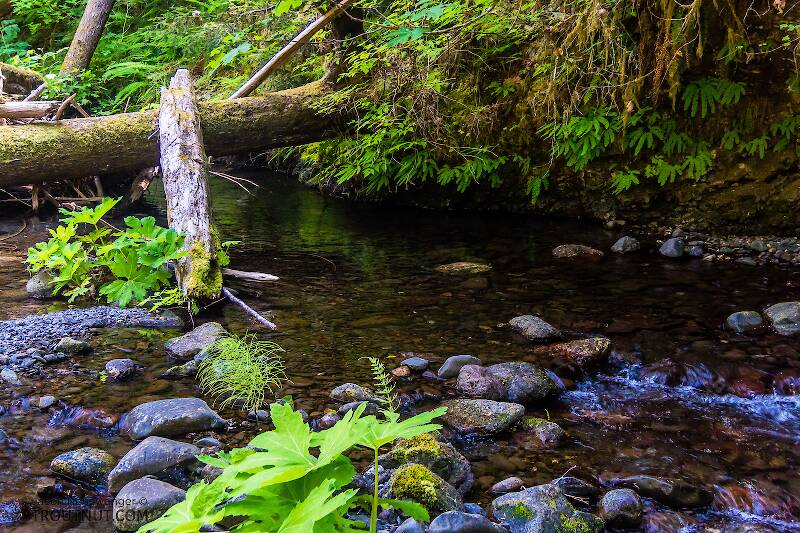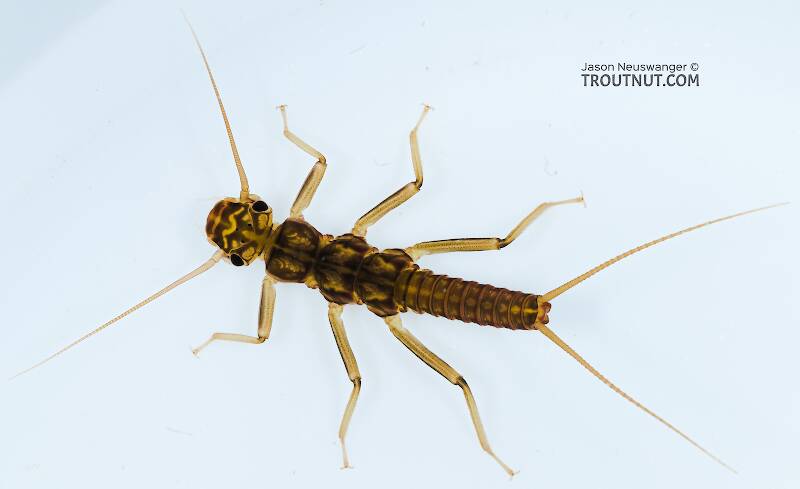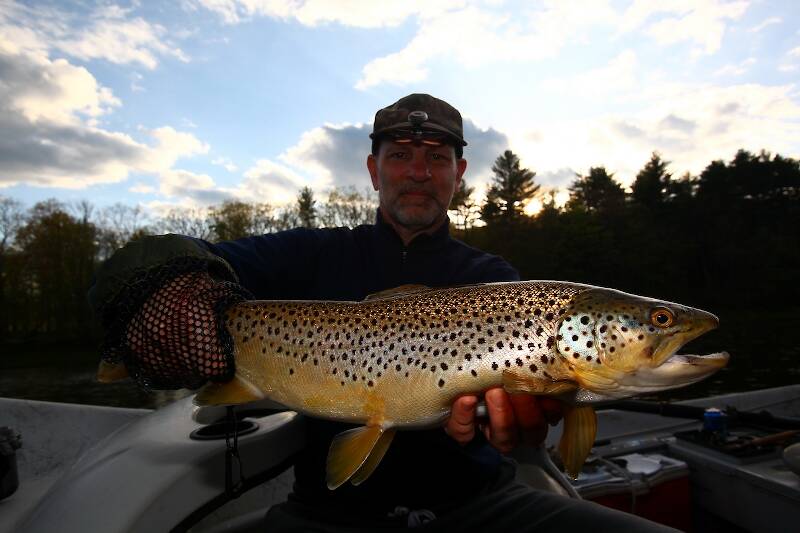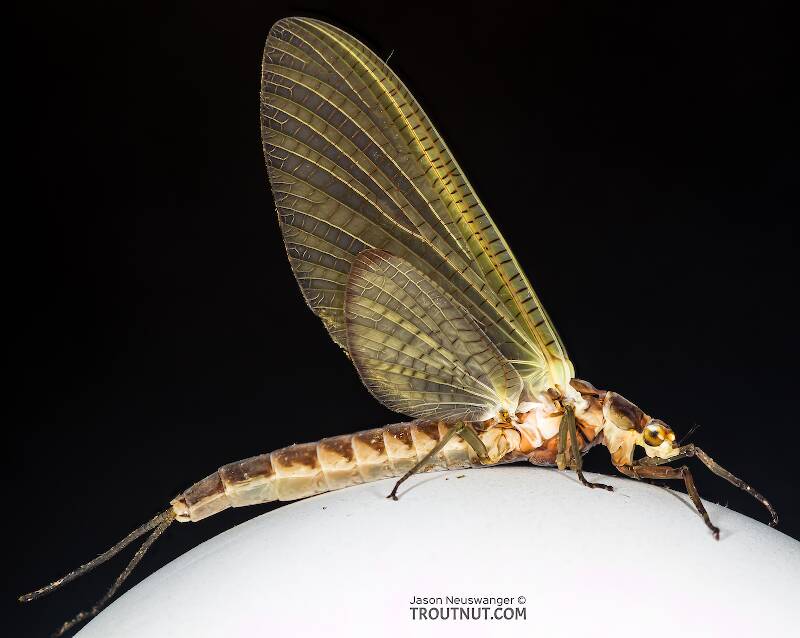
Hex Mayflies
Hexagenia limbata
The famous nocturnal Hex hatch of the Midwest (and a few other lucky locations) stirs to the surface mythically large brown trout that only touch streamers for the rest of the year.
Featured on the forum

Troutnut is a project started in 2003 by salmonid ecologist Jason "Troutnut" Neuswanger to help anglers and
fly tyers unabashedly embrace the entomological side of the sport. Learn more about Troutnut or
support the project for an enhanced experience here.
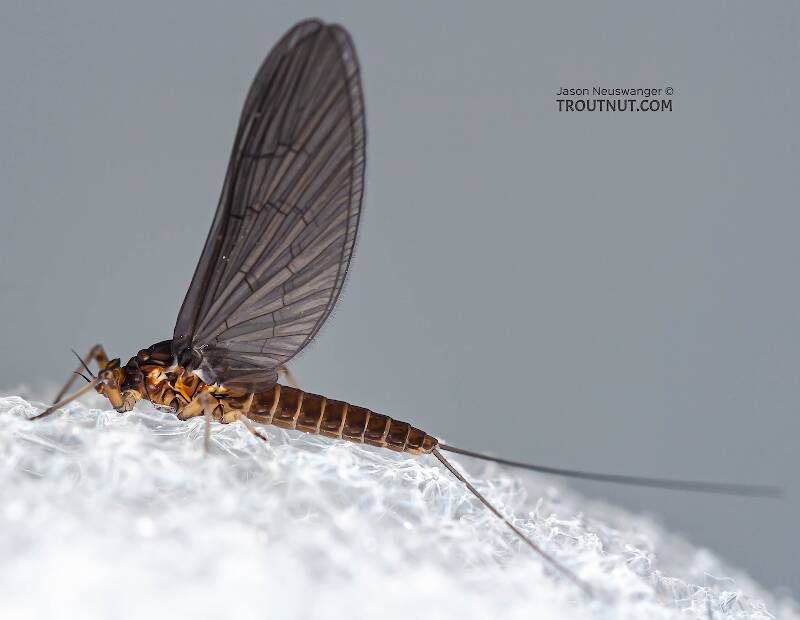
This little early-season dun molted into this spinner after I photographed her.
DarkDun
Posts: 16
Posts: 16
DarkDun on Jan 16, 2007January 16th, 2007, 6:28 am EST
Hook:#20
Thread: Deep Brown 8/0
Wings: Dark Dun
Tails: Dark Dun Split
Abdomen: Stripped Dark brown hackle
Thorax:Rusty Brown Dubbing
Legs: Light Brown or Cree hackle tied sparse
Does this sound good? Would like to here some comments about successful paterns
Thread: Deep Brown 8/0
Wings: Dark Dun
Tails: Dark Dun Split
Abdomen: Stripped Dark brown hackle
Thorax:Rusty Brown Dubbing
Legs: Light Brown or Cree hackle tied sparse
Does this sound good? Would like to here some comments about successful paterns
Troutnut on Jan 16, 2007January 16th, 2007, 10:36 am EST
Looks pretty good. I'm not sure I would use rusty brown dubbing, though -- maybe mix about 2/3 rusty brown, 1/3 medium gray/dun. It'll look a bit too light and get darker in the water.
Jason Neuswanger, Ph.D.
Troutnut and salmonid ecologist
Troutnut and salmonid ecologist
Troutnut on Jan 16, 2007January 16th, 2007, 10:36 am EST
Looks pretty good. I'm not sure I would use rusty brown dubbing, though -- maybe mix about 2/3 rusty brown, 1/3 medium gray/dun. It'll look a bit too light and get darker in the water.
Jason Neuswanger, Ph.D.
Troutnut and salmonid ecologist
Troutnut and salmonid ecologist
Martinlf on Jan 16, 2007January 16th, 2007, 11:37 am EST
Take a look at Fly-Fishing Pressured Water, by Lloyd Gonzales, aka Gonzo. I've been tying his patterns, trying all the mayfly styles that seem appropriate for baetis.
Here is another, Rs2 style emerger I like, but I sometimes use a biot for the body. I like the tail sparse to imitate the shuck. This works as a wet fly also.
Hook- Tiemco 921 16-20. Measure this short hook to get the right size for the fly.
Tail-dun CDC or aftershaft feathers. Tie in a
Clump 3/4 as long as the hook shank and secure it at the
Bend of the hook. Wind the thread forward to form a thin tapered body.
Tie in a clump of stripped CDC or aftershaft feather to form the
Wing Sprouts. Or use CDC tips. The wing should be 1/2 the length of the hook shank. You can tie in longer and trim. Whip finish.
adapted from: Little Lehigh Flyshop
scroll down a bit to find the original pattern
Here is another, Rs2 style emerger I like, but I sometimes use a biot for the body. I like the tail sparse to imitate the shuck. This works as a wet fly also.
Hook- Tiemco 921 16-20. Measure this short hook to get the right size for the fly.
Tail-dun CDC or aftershaft feathers. Tie in a
Clump 3/4 as long as the hook shank and secure it at the
Bend of the hook. Wind the thread forward to form a thin tapered body.
Tie in a clump of stripped CDC or aftershaft feather to form the
Wing Sprouts. Or use CDC tips. The wing should be 1/2 the length of the hook shank. You can tie in longer and trim. Whip finish.
adapted from: Little Lehigh Flyshop
scroll down a bit to find the original pattern
"He spread them a yard and a half. 'And every one that got away is this big.'"
--Fred Chappell
--Fred Chappell
Quick Reply
Related Discussions
Topic
Replies
Last Reply
2
Sep 5, 2012
by Sayfu
by Sayfu

